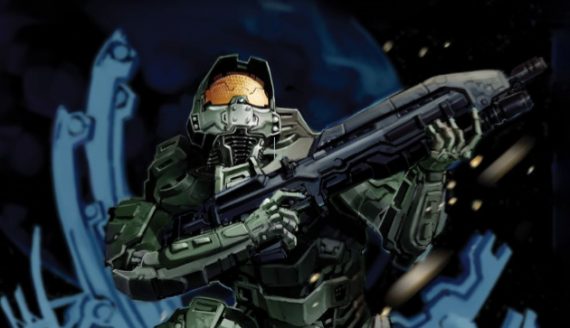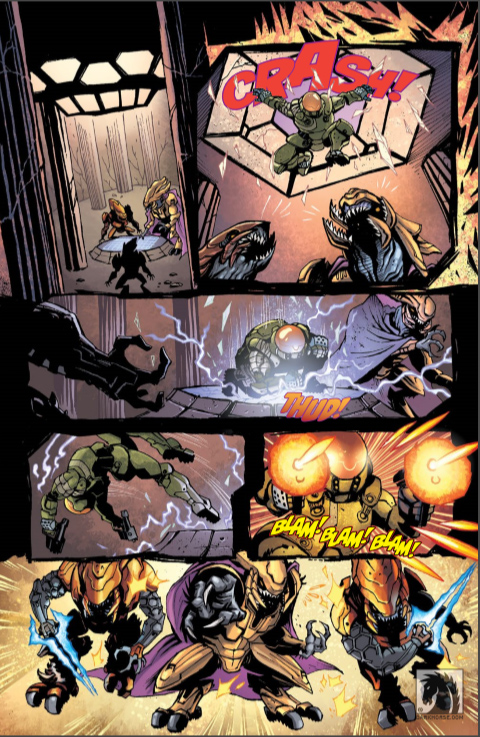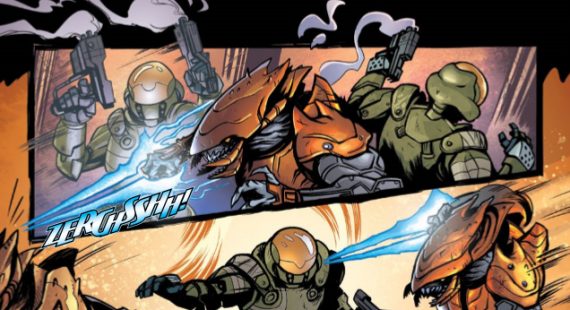Halo: Tales from Slipspace Interview

I recently had the opportunity to read through Halo: Tales from Slipspace published by Dark Horse Comics which features plenty of action for Halo fans to check out. The anthology contains seven different short stories scripted by seven different writers that make up over 100 pages in the graphic novel. Stories range from straight up action to a conflict between the crew of a broken ship stranded in space.
There’s also a highly interesting tale at the very end that includes some backstory on Cortana. The story script is by 343 Industries’ Franchise Development Director, Frank O’Connor, and I think it’s highly worth the read.
Outside of being able to read through seven different tales set in the Halo Universe, there’s also some bonus content included as a few concept artists at 343 Industries contributed their time to have their unique artwork added in a special gallery at the very end of the book. I feel that fans will certainly appreciate this section.
Being a huge Halo fan I made sure to read through the graphic novel immediately, but I also wanted to connect with the artists and script writers behind Halo: Tales from Slipspace to learn even more about them and ask what it was like to work on this project.
Check out my interview below with three of the guys behind Halo: Tales from Slipspace.
I first spoke with John Jackson Miller, script writer for the story Undefeated.
Andrew Stevens (AS): Tell us about your thought process and inspiration for the creation of the story Undefeated.
John Jackson Miller: I knew that the ending of Halo 5: Guardians would have a significant impact on a lot of different lives — and importantly, I knew that the nature of the ending was such that not everyone affected would know what had happened to them, and why. Focusing on a military ship trapped in interstellar space and out of contact gave me a closed setting that would allow paranoia to come to the fore. So we have people working desperately to save themselves — while at the same time they’re arguing with one another about what has happened, and what steps they should be taking.
So I would say that while on a more surface level there are of course callbacks to films like Apollo 13, and the astronauts trying to get home, inspiration also came from places like the old Hitchcock movie, Lifeboat, which had that kind of paranoia afoot.
AS: What does Halo mean to you and what was it like working on Halo: Tales from Slipspace?
John Jackson Miller: I’ve worked on comics for other video game franchises, but in those cases it was a lot earlier in the development of the multimedia universes. Halo is well established and has a huge fan base already, and quite a lot of lore developed. So in this and in my story for the prose Halo: Fractures: anthology I looked to tell stories with relatively narrow footprints nestled in isolated spots within the continuity. Once I knew what I wanted to do, the 343 studio team was right there to help integrate my stories fully into the canon. And as I got more and more into the story world, I found all sorts of things that could be played upon thematically.
So it’s been fun. Hopefully “Undefeated” will be a worthy addition to that body of work.
Next up I spoke with Jonathan Goff, script writer for the story Hunting Party.
AS: Tell us about your thought process and inspiration for the creation of the story Hunting Party.
Jonathan Goff: “Hunting Party” was born of my desire to add a just little something more to corner of the Halo universe that “Headhunters” from Halo: Evolutions inhabits. The first thought was to simply tell a quick, all-action story from the POV of a group of spec ops Elite assassins that are of a kind with the Elites in Headhunters — top of the line, behind enemy lines master killers. 343 then brought Atriox to the table and the original idea was reworked to make it much less about an Elite’s struggle with unending vengeance and more about the consequences of being blinded by that vengeance.
Aside from the set up for the Elites, I reworked the whole story to take advantage of Atriox and his voice within the universe, so the Elites, who were originally straight-forward protagonists, actually have their place within the story shift. The fun there is that I think you can actually enjoy this story from two perspectives. One where the Elites are the protagonists and their end fate, good or ill, can be judged by the reader. The other viewing the Elites as the antagonists and Atriox as the protagonist. Neither option is wrong. After all, this is a fictional intergalactic war. Pick a side or sides. Or just enjoy the ride!
AS: What does Halo mean to you?
Jonathan Goff: This would be a three hour conversation if we were to dive into the depths of what Halo means to me – the story and mystery of its universe entertain and inspire to no end, the countless hours of LAN parties and Xbox Live multiplayer matches I’ve played and the friends made through those experience are all invaluable. But, Halo’s greatest take away for me is the sense of wonder it provides. I’ve said this before (and will again, ad infinitum), but wonder matters. Wonder inspires. Wonder asks us to ask questions and find answers. And wonder in entertainment makes it more than just entertainment. It makes it an experience you can take with you — that you can dwell on and dream about and be inspired by. I think Halo provides wonder in so many ways and I think that’s a main ingredient in its connection with so many people.
AS: What was it like working on Halo: Tales from Slipspace?
Jonathan Goff: Great. Tremendous. 343 is always a pleasure to work with. They know the Halo universe back and forth and allow creators the freedom to create in their own voice as long as they are working with the established rules of the canon. This is my first time working with Dark Horse, but they’ve been great as well. The personal highlight for me — aside from getting to add another small piece to the Halo fictional sandbox, which I love — was being lucky enough to have Simon Roy, an artist whose work I admire, illustrate “Hunting Party.” Simon brought Sandra Lanz on board to color his lines, which made for a final product that I’m not just proud of, but a fan of. And, Michael Heisler, who lettered “Hunting Party,” gave the words life in a way that incorporated my various nontraditional asks in a seamless, organic fashion that brought the whole thing together perfectly.

AS: You did the art for one of the more interesting tales in the book, Knight Takes Bishop, as it’s basically a mission briefing followed by pure action. What’s it like for you as an artist to work on a graphic novel based on one of the most popular games ever?
Dave Crosland: It was great having the opportunity to play in the wildly popular sandbox that is the world of Halo. I’ve worked on several licensed properties that became comic books, and the key for me has always been finding a creative strand in the franchise that truly resonates with me. In our short story “Knight Takes Bishop,” that strand was the concept of a cybernetic soldier pulling off a black ops mission against high-tech aliens. Once I tapped into that wave, I was able to ride it straight to the core of our story and mine for visual ore.
AS: How fun is it for you as an artist to pretty much tell the entire story of Knight Takes Bishop completely by art?
Dave Crosland: It was fun, yet challenging. The fact that Tyler Jeffers’ script for “Knight Takes Bishop” was 90% action allowed me to go wild with the artwork. And once we got Len O’Grady onboard as colorist, I knew we could make something visually stunning that was a lot of fun to read. Len is a chromatic master, and I think his colors & visual effects are what ultimately makes our story sing with so much energy.
While I’m not averse to reading, I appreciate a sequential story that is told entirely through art. It takes real talent to craft a story without a single printed word. It also makes the story more accessible to an international audience, since language isn’t a necessary part of the experience. And that’s a concept I’ve always enjoyed playing with.
AS: What does Halo mean to you and what was it like working on Halo: Tales from Slipspace?
Dave Crosland: To me, Halo is Starship Troopers on steroids. It’s a delicious recipe for exciting gameplay, intense storytelling and unlimited world building.
Working on our story for Halo: Tales from Slipspace was a welcome chance for me to experiment and apply my energetic style to the meticulous detail of Halo’s characters, tech and creature design. Ultimately, making “Knight Takes Bishop,” gave me the opportunity to play in the vast world of Halo via one of my oldest loves: comic books! And I was grateful to add my voice to the well-established chorus of creativity, all based in this expansive universe that began as a groundbreaking video game and grew into a multimedia empire.
Thank you John, Jonathan, and Dave for taking the time to answer my questions. I really enjoyed hearing your answers and feel they add more to the stories you worked on in Halo: Tales from Slipspace. I have a great amount of respect for your creativity and vision of being able to establish new stories and create art for such a popular series.
Halo: Tales from Slipspace is available now on Amazon through Kindle or ComiXology for $12.99, or as a hardcover copy for $16.81.



Responses